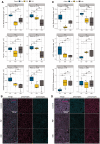Contribution of the astrocytic tau pathology to synapse loss in progressive supranuclear palsy and corticobasal degeneration
- PMID: 33089580
- PMCID: PMC8412068
- DOI: 10.1111/bpa.12914
Contribution of the astrocytic tau pathology to synapse loss in progressive supranuclear palsy and corticobasal degeneration
Abstract
Primary 4-repeat tauopathies with frontotemporal lobar degeneration (FTLD) like Progressive Supranuclear Palsy (PSP) or Corticobasal Degeneration (CBD) show diverse cellular pathology in various brain regions. Besides shared characteristics of neuronal and oligodendroglial cytoplasmic inclusions of accumulated hyperphosphorylated tau protein (pTau), astrocytes in PSP and CBD contain pathognomonic pTau aggregates - hence, lending the designation tufted astrocytes (TA) or astrocytic plaques (AP), respectively. pTau toxicity is most commonly assigned to neurons, whereas the implications of astrocytic pTau for maintaining neurotransmission within the tripartite synapse of human brains is not well understood. We performed immunofluorescent synapse labeling and automated puncta quantification in the medial frontal gyrus (MFG) and striatal regions from PSP and CBD postmortem samples to capture morphometric synaptic alterations. This approach indicated general synaptic losses of both, excitatory and inhibitory bipartite synapses in the frontal cortex of PSP cases, whereas in CBD lower synapse densities were only related to astrocytic plaques. In contrast to tufted astrocytes in PSP, affected astrocytes in CBD could not preserve synaptic integrity within their spatial domains, when compared to non-affected internal astrocytes or astrocytes in healthy controls. These findings suggest a pTau pathology-associated role of astrocytes in maintaining connections within neuronal circuits, considered as the microscopic substrate of cognitive dysfunction in CBD. By contrasting astrocytic-synaptic associations in both diseases, we hereby highlight astrocytic pTau as an important subject of prospective research and as a potential cellular target for therapeutic approaches in the primary tauopathies PSP and CBD.
Keywords: astrocytic plaques; corticobasal degeneration; progressive supranuclear palsy; synapse loss; tauopathy; tufted astrocytes.
© 2020 The Authors. Brain Pathology published by John Wiley & Sons Ltd on behalf of International Society of Neuropathology.
Conflict of interest statement
The authors declare that they have no competing interests.
Figures




Similar articles
-
Astrocytic inclusions in progressive supranuclear palsy and corticobasal degeneration.Neuropathology. 2014 Dec;34(6):555-70. doi: 10.1111/neup.12143. Epub 2014 Aug 14. Neuropathology. 2014. PMID: 25124031 Review.
-
Case report of a patient with unclassified tauopathy with molecular and neuropathological features of both progressive supranuclear palsy and corticobasal degeneration.Acta Neuropathol Commun. 2023 Jun 1;11(1):88. doi: 10.1186/s40478-023-01584-z. Acta Neuropathol Commun. 2023. PMID: 37264457 Free PMC article.
-
Single-nucleus chromatin accessibility profiling highlights distinct astrocyte signatures in progressive supranuclear palsy and corticobasal degeneration.Acta Neuropathol. 2022 Oct;144(4):615-635. doi: 10.1007/s00401-022-02483-8. Epub 2022 Aug 17. Acta Neuropathol. 2022. PMID: 35976433 Free PMC article.
-
Machine learning-based decision tree classifier for the diagnosis of progressive supranuclear palsy and corticobasal degeneration.Neuropathol Appl Neurobiol. 2021 Dec;47(7):931-941. doi: 10.1111/nan.12710. Epub 2021 Apr 7. Neuropathol Appl Neurobiol. 2021. PMID: 33763863 Free PMC article.
-
Chameleons and mimics: Progressive supranuclear palsy and corticobasal degeneration.Neuropathology. 2020 Feb;40(1):57-67. doi: 10.1111/neup.12590. Epub 2019 Sep 12. Neuropathology. 2020. PMID: 31515852 Review.
Cited by
-
Expression of ITPR2 regulated by lncRNA-NONMMUT020270.2 in LPS-stimulated HT22 cells.Heliyon. 2024 Jun 25;10(13):e33491. doi: 10.1016/j.heliyon.2024.e33491. eCollection 2024 Jul 15. Heliyon. 2024. PMID: 39040287 Free PMC article.
-
Pathological Impact of Tau Proteolytical Process on Neuronal and Mitochondrial Function: a Crucial Role in Alzheimer's Disease.Mol Neurobiol. 2023 Oct;60(10):5691-5707. doi: 10.1007/s12035-023-03434-4. Epub 2023 Jun 19. Mol Neurobiol. 2023. PMID: 37332018 Review.
-
The reduction of astrocytic tau prevents amyloid-β-induced synaptotoxicity.Brain Commun. 2022 Sep 19;4(5):fcac235. doi: 10.1093/braincomms/fcac235. eCollection 2022. Brain Commun. 2022. PMID: 36196088 Free PMC article.
-
Genetic and Epigenetic Constructs of Progressive Supranuclear Palsy.Ann Neurosci. 2022 Apr;29(2-3):177-188. doi: 10.1177/09727531221089396. Epub 2022 Apr 27. Ann Neurosci. 2022. PMID: 36419517 Free PMC article. Review.
-
Pathomechanisms of depression in progressive supranuclear palsy.J Neural Transm (Vienna). 2023 Aug;130(8):1049-1056. doi: 10.1007/s00702-023-02621-w. Epub 2023 Mar 18. J Neural Transm (Vienna). 2023. PMID: 36933007 Review.
References
-
- Bernardinelli Y, Randall J, Janett E, Nikonenko I, König S, Jones EV, et al. Activity‐dependent structural plasticity of perisynaptic astrocytic domains promotes excitatory synapse stability. Curr Biol. 2014;24:1679–88. - PubMed
-
- Bigio EH, Brown DF, White CL. Progressive supranuclear palsy with dementia: cortical pathology. J Neuropathol Exp Neurol. 1999;58:359–64. - PubMed
-
- Bigio EH, Vono MB, Satumtira S, Adamson J, Sontag E, Hynan LS, et al. Cortical synapse loss in progressive supranuclear palsy. J Neuropathol Exp Neurol. 2001;60:403–10. - PubMed
Publication types
MeSH terms
Substances
LinkOut - more resources
Full Text Sources
Medical
Miscellaneous

